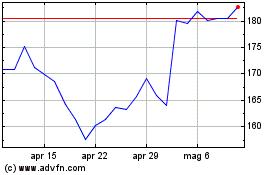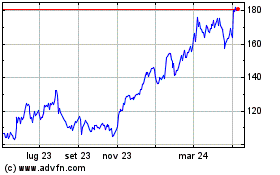By Asa Fitch
Nvidia Corp., the computer-graphics giant that made a successful
bet on chips purpose-built for artificial intelligence, is facing
new threats to its market dominance as rivals enter a
multibillion-dollar race to power everything from customer-service
chatbots to robotic lawn mowers.
Qualcomm Inc., long the leading designer of silicon for
smartphones, unveiled a new AI chip last month for use in cloud
computing that it plans to sell next year. Graphcore, a U.K.
chip-making startup that recently secured $200 million in new
funding from investors including Microsoft Corp., is testing its
chips and plans to release them commercially in the second half of
this year.
Underlining the commercial prospects for AI hardware, Hewlett
Packard Enterprise Co. on Friday reached a deal to acquire Cray
Inc., a company that makes high-end equipment for supercomputers
that are increasingly being deployed for AI research.
Demand for chips specialized for AI is growing at such a pace
the industry can barely keep up. Sales of such chips are expected
to double this year to around $8 billion and reach more than $34
billion by 2023, according to Gartner projections.
That growth is creating opportunities for everyone. But with
increasing competition, it will be harder for a single company to
stay on top of the race for performance, said Linley Gwennap, the
president of the Linley Group, a Silicon Valley research
outfit.
"When you have so many different companies, there's a new chip
coming out every month, and if that one happens to grab the lead,
how long are they going to stay there?" he said. "There is going to
be a lot of this leapfrogging going on."
Nvidia owns about three-quarters of the market for AI chips,
based on Gartner estimates. Jensen Huang, Nvidia's chief executive,
said some of the most sophisticated AI algorithms recently had been
developed using Nvidia hardware.
He said Nvidia also is working to make its portfolio more
flexible for customers by customizing its robust general-purpose
chips with AI-specific circuitry -- and developing software to
speed things up further. "I think that's a really great advantage,"
he said.
AI software enables computers to mimic human activity such as
having conversations, making recommendations and avoiding obstacles
on the street. Such systems require machines to perform a
gargantuan number of simple calculations at the same time. That
kind of math has traditionally been done by the central processing
unit, or CPU -- the brain of a computer. Yet CPUs, which make their
calculations one after another, aren't as good at the task as chips
with lots of small brains making calculations at the same time.
Nearly a decade ago, Nvidia recognized graphics processing units
it sold for videogame enthusiasts and other niche buyers -- chips
that calculate how to display animated pixels on a computer screen
-- were well-suited to AI because they work largely in
parallel.
The Santa Clara, Calif., company plowed investment into adapting
its chips for AI, positioning itself for a boom. Nvidia booked
almost $3 billion in revenue last year from selling AI chips used
in data centers. Its stock price has risen more than eightfold over
the past five years.
On Thursday, Nvidia reported quarterly earnings that fell 68%
but beat analysts' expectations. A slowdown in data centers where
the company's AI chips primarily reside was one factor that led to
the decline. Cloud companies that made significant purchases last
year are getting the most out of existing chips before buying new
ones, Mr. Huang said.
Chip companies aren't the only ones building AI silicon.
Cloud-computing giants like Amazon.com Inc. and Alphabet Inc., huge
buyers of Nvidia's chips, have started to design their own to meet
their customers' specific needs. Their size -- Amazon's cloud unit
had $25.66 billion in revenue last year -- give them ample
resources to fund the high cost of development.
"We can aggregate a bunch of customer demand on any workload
type and justify investing in one of the specialized chips," said
Peter DeSantis, vice president of global infrastructure at Amazon
Web Services. In November, the Amazon cloud unit unveiled a custom
processor called Inferentia optimized for a form of artificial
intelligence called machine learning. The processors are to be
deployed on AWS; Amazon doesn't plan to offer them to other
companies.
Intel Corp., already the biggest supplier of chips for computer
servers, has gained a sizable foothold in AI chips for data centers
by tweaking some of its most powerful CPUs to do better at AI
tasks.
Smaller companies, too, are building AI chips from the ground
up. They include startups Mythic Inc., Graphcore and Habana Labs
Ltd., which have drawn a surge of venture-capital interest after
many years during which early-stage investors shunned chips.
Nigel Toon, CEO of three-year-old Graphcore, said the company is
hiring hundreds of people in anticipation of its first commercial
products.
The advances that the coming wave of chips enable won't be
immediately apparent to most consumers. But people's interactions
with digital assistants like Amazon's Alexa and Apple Inc.'s Siri
should become more fluid, and devices will be able to tailor their
machine brains specifically to their owners -- such as allowing a
video security system to recognize a house's occupants so it can
distinguish them from intruders.
Despite the rapid progress seen in recent years, AI chip
development still has a long way to go before it reaches maturity,
said Naveen Rao, head of Intel's AI chip business.
"It's a very interesting point in time, kind of like the early
1900s and the introduction of flight, where the basic principles of
flight were discovered," he said. "Once you know these basic ideas,
then you iterate on them."
Write to Asa Fitch at asa.fitch@wsj.com
(END) Dow Jones Newswires
May 19, 2019 12:14 ET (16:14 GMT)
Copyright (c) 2019 Dow Jones & Company, Inc.
Grafico Azioni QUALCOMM (NASDAQ:QCOM)
Storico
Da Mar 2024 a Apr 2024

Grafico Azioni QUALCOMM (NASDAQ:QCOM)
Storico
Da Apr 2023 a Apr 2024
